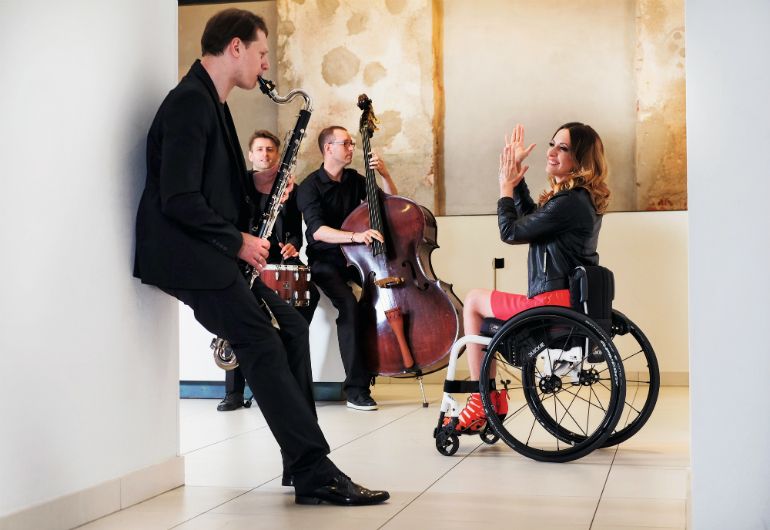Share:
Take it offline!
This Education in Motion resource is also available as a printable PDF.
Download PDF
Music has a beautiful power to move us, uplift our moods, motivate us, and connect us with our friends and family. It helps us to communicate and express our feelings, and to understand the world and people around us with a new level of depth. Songs and rhythms not only entertain and delight us; there is scientific evidence that certain beats can increase mental wellness, reduce pain, and even improve our sleep.
With all of this considered, it is only natural that music can also be a form of formal therapy. Music can help to facilitate a connection between a patient and their therapist, helping them to create a goal-oriented treatment plan. Music therapy is patient-centered, and every session is unique and tailored to the patient’s needs.
In passive music therapy, you will listen to calming music and be invited to visualize peaceful images, while active music therapy sessions will have you working with your therapist to play and improvise music. . During an active music therapy appointment you might listen to music, play an instrument, practice singing, write a song, or even dance.
What are some of the benefits of music therapy?
People have embraced music’s therapeutic powers throughout history. In World War II, doctors and nurses noted the remarkably positive effect that music played by volunteers had on the wellbeing of wounded soldiers in army hospitals. It was so effective that, by the time the War ended, some doctors were paying musicians to play to their patients.
- Music therapy helps us to connect with others, understand each other, and express our emotions.
- It helps to distract us from pain and reduce general anxiety.
- As a result of helping us to manage stress, music can improve our respiration, lower our blood pressure, and relax any muscle tension we are experiencing.
- Music is extremely comforting, and can evoke happy memories and positive thoughts.
- It can improve our overall well-being by uplifting our mood and helping us to connect and relax.
“Music expresses that which cannot be put into words.” - Victor Hugo

How does music therapy achieve these results?
According to board-certified music therapist Kimberly Sena Moore, our brains learn from an early age to process and respond to music. In an interview with brainHQ she says about the importance of music, “mothers across cultures and throughout time have used lullabies and rhythmic rocking to calm crying babies. From an evolutionary standpoint, music precedes language.”
Kimberly then explains that our motor systems automatically adjust to match a rhythm or beat when we hear it. Some of the music that enters our central nervous system through our auditory pathways heads directly to the motor nerves in our spinal cord. This explains how our muscles can automatically move in time with a rhythm, like when we absentmindedly tap our feet along to the beat of a song. Music therapists can even use this to help people who have had strokes relearn how to walk.
Our bodies respond physiologically to music. Rhythms can affect our breathing, heart rate, muscles, and even our brainwaves. This is especially useful for helping us to relax, but it can also stimulate learning, recall, and even motivation. In fact, music is so tied in so closely with our brains that singing uses the same neural circuits as speaking. This is how music therapists deliver speech therapy and help their patients relearn how to talk and communicate after injury or illness.
Music Therapy Associations and Resources in Australia
The Australian Music Therapy Association
The Australian Music Therapy Organisation, or ATMA, is the leading representative body for Australian music therapy. ATMA advocates for accessibility to music therapy, stages annual national conferences for therapists, runs workshops and events, and provides valuable information about music therapy for NDIS participants. It also assesses and accredits associated university courses and manages the Registered Music Therapy accreditation system for Australian music therapists. Each year, ATMA publishes the Australian Journal of Music Therapy, an informative and peer-reviewed open access online journal.
Nordoff-Robbins Music Therapy Australia
Nordoff-Robbins Music Therapy Australia is a non-profit organisation that provides a variety of music therapy programs. Based in New South Wales, it delivers music therapy to schools, preschools, disability organisations, hospitals, aged care facilities, and a variety of other community organisations. Alongside its music programs, the organisation also runs a range of workshops for health professionals, carers, families, support staff, teams, and other professionals.
Music is an impactful therapeutic tool. It is non-invasive, safe, comforting, and motivating. Creating and listenings to songs can uplift and empower us, improve our well-being, and even help us manage pain. If you are ready to begin your journey with music therapy, you can search for a music therapist in your local area in Austmta.org.au.
In order to keep up to date with other therapies and health topics, don’t forget to visit our blog and subscribe to our newsletter to get all the news straight into your inbox.